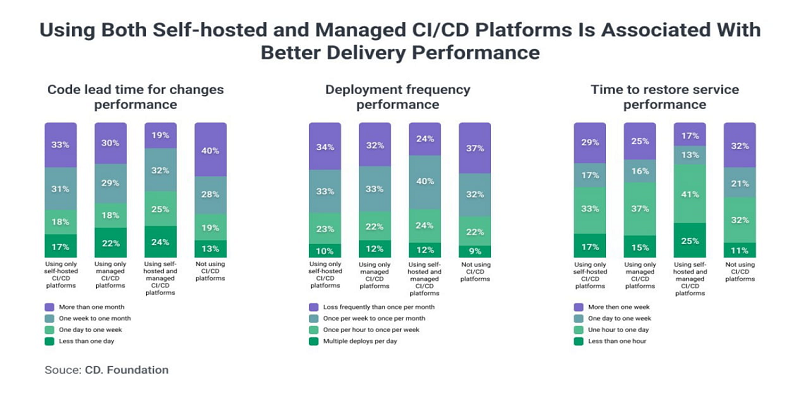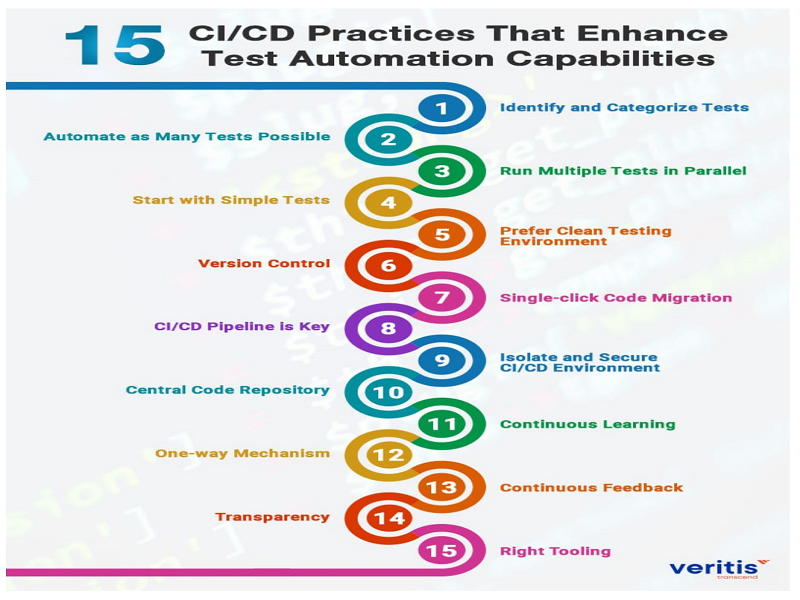By Inioluwa Shittu
Picture this: it’s 9:45 p.m. on a Monday; your team’s Slack is quiet, inactive, even. You’ve just pushed a major update to production, using your CI/CD pipeline, and your stomach does that little swerve all DevOps Engineers know too well when nervous. ‘The deployment should be fine,’ you tell yourself. But then again, we both know, ‘fine’ isn’t good enough when it comes to the cloud.
According to a 2024 State CI/CD Report, CI/CD is particularly aligned with improved delivery performance. While 40% of developers not using CI/CD platforms reported a code lead time for performance changes of more than a month, this figure dropped to just 19% for those using self-hosted platforms.
In this article, I’ll highlight real-world case studies, frameworks and lessons I’ve utilised to create faster, safer deployment pipelines.

CI/CD In the Cloud
When we refer to CI/CD, what do we imply?
CI/CD stands for Continuous Integration and Continuous Deployment. Essentially, it’s a software development approach where developers make small, incremental code changes and monitor their reliability. When someone updates the code, for instance, automated build and test processes are implemented to catch unwarranted problems early on. The code is then delivered quickly and seamlessly as part of the CD process.
Now, we’ll proceed with some of the main advantages of CI/CD:
- Test Automation: This helps detect defects early. Catching bugs and detecting inconsistencies is where test automation comes in.
- End-to-end pipelines: When a CI/CD is solid, the setup automatically links everything together throughout the software delivery lifecycle, from source code to testing, monitoring, and more.
- Analytics and Reporting: These tools help teams understand which builds are failing and how often releases succeed.
- Build Automation: With CI/CD, tasks are handled seamlessly through scripts and tools. It helps to reduce human errors and shortens release timelines.

Best Practices

When dealing with CI/CD, there are certain practices which are pertinent to adopt, because they impact every process necessary for software engineering and operations. Let’s delve into some of them.
Prioritise Security
CI/CD pipelines these days provide seamless integration. To go through automated security checks directly into your software delivery workflow. These checks go beyond just scanning code binaries. Rather, they also include cross-checking Kubernetes configurations, Terraform scripts, and other infrastructure files. When you perform these scans regularly, you’re sure to avoid possible issues.
Keep Builds Fast & Feedback Immediately
Trust me, when it comes to build times, speed matters. It is one of the core ingredients in this recipe. Frequent commits mean frequent builds. If your builds are slow, the very system designed to accelerate development can start to feel burdensome. Fast builds are essential in keeping engineering workflows efficient, smooth and focused.
Automated Testing:
Automated Testing can be broken into three key categories;
- Unit tests: which focus on ensuring individual functions are verified in isolation.
- Functional tests: This enhances real-world usage and ensures that the overall process works perfectly for end users.
- Integration tests: examine the interaction of diverse kinds of systems. It also helps to reveal concealed viruses that can come about when components sync.
Teams can provide meaningful feedback to developers early in the process by designing a thoughtful strategy across these layers.
Observe and Monitor Your Pipeline
You may think minor pipeline delays are harmless. Wait until they pile up. Especially as more tests, code changes or faulty caching begin to weigh things down. If left unchecked, these slow creeps can quietly erode team efficiency. It is essential to regularly and proactively monitor your entire pipeline.
Know the Right Tools to Use
When you build dependable and repeatable workflows, it also requires you to develop specialised debugging skills. Don’t rely on outdated automation, largely because it won’t aid in solving the problems that need to be solved. It’s pertinent always to choose solutions that truly fit your needs. One of the many reasons why teams struggle with tooling is vendor lock-in. While many development platforms provide powerful tools, it’s ultimately up to you to ensure they align with your specific goals.
Real-World Case Study
Let’s delve into the real-world case study of the largest African banking group, by assets, named Standard Bank, whose headquarters are in Johannesburg.
With over 2,000 IT systems and operations across 20 countries, the bank faced mounting pressure to modernise its software delivery, reduce costs, and improve customer experience. The company then adopted SAFe (Scaled Agile Framework and DevOps practices to drive enterprise-wide transformation. These practices thus included: Agile Release Trains (ARTs), Automation, Culture Shift, DevSecOps and Cloud adoption.
Of course, there were subsequent positive results; the Time-to-market reduced from 700 days to just 30 days. There were deployment frequencies, productivity, cost savings, organisational health and customer experience.
The lessons learned and the realisation that came from confronting these challenges reinforced Standard Bank’s belief that building the right culture is always the essential starting point. Technical change is impossible without behavioural change. There’s also the need for team empowerment, measurement and investment in skills.
Conclusion
Overall, CI/CD practices are intended to help enterprises and development teams produce the best software possible and minimise the pains common with integrating multiple branches or checking for security flaws. The practices discussed in this piece can significantly enhance your software delivery and help identify and resolve bugs, unforeseen issues, and other problems.
About The Author
Inioluwa Shittu is a Certified AWS DevOps Engineer and Solutions Architect, with years of in-depth knowledge of cloud computing strategies (IaaS) & building, deploying, and maintaining cloud environments.
He is experienced in Bash and Python scripting, with a focus on DevOps tools, CI/CD, and AWS cloud architecture, as well as hands-on engineering. He is also skilled in administering environments running Windows, Ubuntu, Red Hat Linux, and CentOS, utilising configuration management tools such as Chef and Ansible.
Shittu is certified by AWS as a Solutions Architect (Associate), which affirms his understanding of best practices for architecting enterprise solutions that are cost-efficient, highly available, and scalable. He also holds a degree from the University of South Wales.

